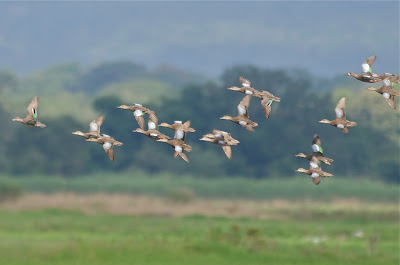The year 2017 is almost here and we are eager to receive it, full of hopes of better days to come and, in my case, wishing for life birds. That could be a quite ambitious wish, since 2016 was pretty exceptional regarding new birds species for my Panama Life List! This year, that is about to end, brought to me 15 amazing lifers plus many range-restricted rarities and even some potential splits. To choose only ten of them was hard task... I took into consideration rarity, relevance for Panama and the region, beauty and general circumstances of the sighting.
 |
| Purple-throated Mountain-Gem (Cerro Hoya) |
10. Purple-throated Mountain-Gem (Cerro Hoya): although strictly talking this species was not a lifer, the truth is that the whole experience of climbing Cerro Hoya, in southern Azuero Peninsula, was amazing. Remote, little explored and full of range-restricted forms, Cerro Hoya probably holds new species for science and this hummingbird certainly is one of those. The main differences with other forms of this species is the tawny belly and the green, non-iridescencent forecrown.
 |
| Typical Coiba Island landscape |
09. Coiba Spinetail: endemic to Panama and restricted to the larger island in the Pacific Ocean of Central America, the Coiba Spinetail was the last endemic I had to see in my country. That day, the Coiba Spinetail was the first of three life birds for the day, the most productive day of the year regarding lifers, but I was unable to get a photo... a nice excuse to return to that paradise island!
 |
| Black-billed Cuckoo |
08. Black-billed Cuckoo: nothing is easier than waiting for the life birds to come to you! And last september 30th, this Black-billed Cuckoo just showed up right in front of my balcony! Yes! It was a lifer, a long-expected one by the way.
 |
| Cave Swallow |
07. Cave Swallow: this extremely rare vagrant to Panama was the only migrant swallow present that November 1st in Finca Bayano (to the east of Panama City) aside of the abundant Barn Swallows. It was just the 6th record for the country, and another addition to the long list of rarities occuring at Finca Bayano this year... a site that proved exceptional regarding rarities.
 |
| Unspotted Saw-whet Owl |
06. Unspotted Saw-whet Owl: this rare owl was re-discovered just three years ago in the upper slopes of the highest mountain of Panama, the Baru Volcano. Thanks to the growing group of Boquete birders, it was regularly recorded this year... the twitch reunited fine birdwatchers, including the top three birders for Panama (according to eBird) and it was a complete success!
 |
| Arctic Tern |
05. Arctic Tern: while visiting a completely new site for me, the Islas Secas Archipelago off the coast of Chiriqui province in the Pacific slope of western Panama, this little fellow allowed nice views and conclusive photos... documentation was important because it was just the forth record for Panama!
 |
| Hudsonian Godwits |
04. Hudsonian Godwit: the third ever recorded Hudsonian Godwit for Panama showed up in Finca Bayano this fall and the news spread like fire! The very same day I saw my life Cave Swallow, the pair of juveniles godwits decided to feed in the open, proving to be an awesome lifer!
 |
| Green-winged Teals |
03. Green-winged Teal: a pair of Green-winged Teals were my last lifer of 2016. Again, Finca Bayano proved spectacular, I was looking for a Northern Pintail reported elsewhere (also rare) when I noticed these birds at flight. Just the third record for Panama, and the first photos for the country!
 |
| Black Noddy |
02. Black Noddy: identified while reviewing the photos after the pelagic trip off the coast of western Azuero last December 4th, this Black Noddy was the second report for Panama and the first one documented with photos, thus it is not longer in the list of hypothetical species for Panama.
 |
| SHARP-TAILED SANDPIPER |
01. Sharp-tailed Sandpiper: I know you already suspected it... not only a life bird... a HUGE one; but also a new species for Panama and Central America! This Asian breeder is regular in some parts of North America, and this is only the second record south of the United States of America. Definitively the rarest of the long list of rarities in Finca Bayano!
I wish to thanks all the birders and friends that accompanied me this year and that helped me to find all these spectacular birds! Next year will be even better! HAPPY NEW YEAR 2017!!!









































